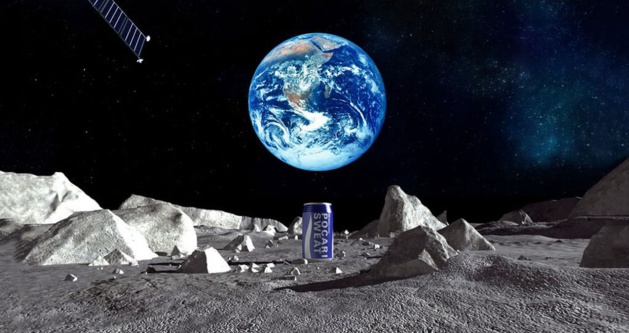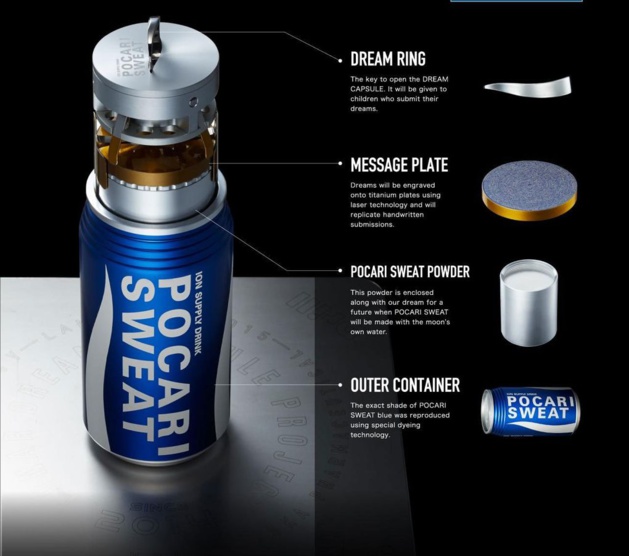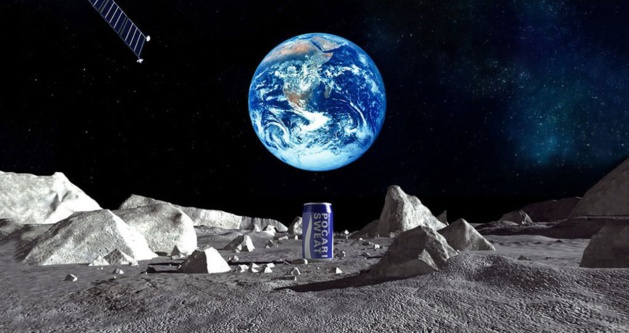
Credit Otsuka Pharmaceutical
The project was entitled “Lunar Dream” and will supposedly be launched during summer 2016, a little later than it should have been. A titanium case will be filled with one kilo of the powdered drink and will be placed into a capsule, which will normally be propelled onto the moon and thus achieve a 380.000 km trip. The rocket that will be used for such a trip will be a Falcon 9, made by the American company SpaceX, which has already successfully achieved three supply missions for the International Space Station. As Otsuka enthusiastically says, “Pocari Sweat” will be the first lunar water beverage in the universe.
A science-centered project
This project was born after one major discovery: there is water on the moon. The first statement on that issue dates back to September 1998, when the NASA published an article in Science Magazine, saying that the results from research mission “Lunar Prospector” show that there is hydrogen on the moon. The investigation went on until the NASA eventually launched a probe in June 2009, named “Lunar Crater Observation and Sensing Satellite”(LCROSS), which showed results that exceeded the scientists' expectations: the surface of the ground on crater Cabeus is composed of about 5,6% of ice. There would therefore be around 600 million metric tons of water on the moon. According to Mrs Yamazaki, a Japanese astronaut, such a huge amount could allow human beings to stay on the moon for very long periods of time.
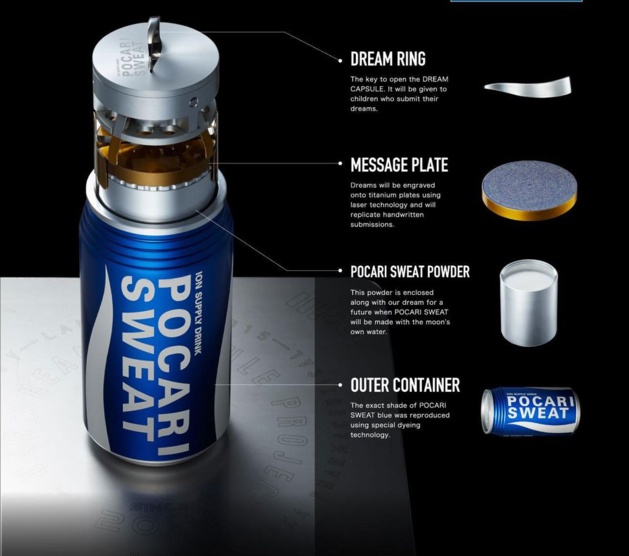
In order to complete its program, Otsuka uses a lander made in an American company based in Pittsburgh, Astrobotic Technology – which, ironically enough, specialises in the development of space-cleaning techniques.
Thanks to this alliance, the start-up hopes to win a $20.000.000 reward offered by Google for the “Lunar X Prize” competition, whose goal is to send a device able to drive for 500 meters on the moon and then send pictures and videos back to Earth. The trip will cost approximately $500.000.
Otsuka also collaborates with a local business in Singapour, Astrocale, for the conception of the titanium container. It has to be capable of supporting lunar conditions for at least three decades. Finally, Japanese SMEs associated with the project for the conception of the capsule.
On a website dedicated to the “Lunar Dream” project, the company makes a brief historical reminder of the conquest of space – from the fights between the USA and the USSR during the Cold War to the elaboration of the Apollo program and, in the 90s, the appearance of other players such as China, India, Japan, Europe, all going for the moon, asteroids and Mars. Otsuka believes that it is all about celebrating the coming of a new kind of player in the game of the conquest of space: private companies. The 2008 Basic Space Law of Japan declares that the national government shall support space development programs from the private sector, in order to promote space industry and encourage international competitiveness.
According to Shinichi Nakasuka, an astronautics teacher at the University of Tokyo, the wheel has already been set in motion: “Nowadays, some wealthy people have already made trips to the International Space Station and stayed there for a week or so, at the price of several billions of yens. In maybe less than 30 years, those people may choose to go on vacation on the moon and, in 30 years, we might be able to travel to the moon the same way we travel overseas today. There will be plants and observatories on the moon, which will speed up space development. You might be sent from Earth to a factory on the moon in order to build a spaceship to reach Mars. Even though a lot more research on the water from the moon will be needed, this isn't science fiction.”
Inspiring the youth
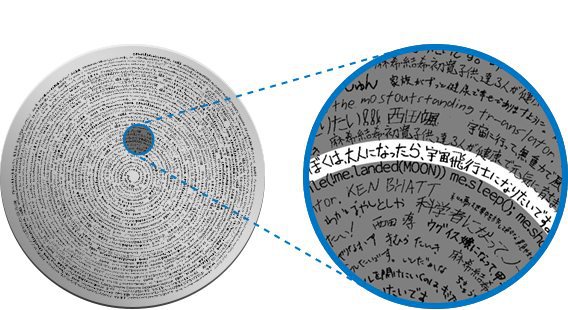
The can would also contain silver discs engraved with messages – or “dreams”, as the company likes to call them – sent using smart phones. The general idea is to give children inspiration to become astronauts, and those who send their dreams will be offered a ring to open the can, and ten of them will be kept in the company's corporate headquarters.
According to Mr Shinichi Asami, from the production department of Otsuka, during his speech at the press meeting on June the 11th 2014, what gave birth to this project was the statement that most of the Japanese youth were unable to answer the question “What is your dream for the future?” whereas children from other Asian countries would immediately say they want to become a teacher, or a police officer, etc. “I am afraid Japanese children have forgotten to have dreams. So I have decided to create this project, which, I hope, will give any people new dreams for the future.” As he was encouraging children to follow their dreams during a press meeting, he added, “When you get depressed, you can look at the moon. I hope the messages you have sent to the moon will give you new energy to achieve your dreams.”
Space considered as a good advertising spot
Although Otsuka's idea is visionary, it is not the first time a company has tried to claim space in order to advertise for its products. Tang, an orange-flavoured powdered drink has already traveled alongside the astronauts of Apollo missions. “Pocari Sweat” will then be the first drink to actually touch the ground of the moon, but this is not a brand new idea, contrary to what it might seem at first sight.
Another example would be that of “Red Bull Stratos” and parachutist Félix Baumgartner: on October the 14th 2012, he jumped from 23 miles above the earth, and was sponsored by the well-known energy drink. Though the brand had put the emphasis on the scientific and medical information such an experiment would give, it appears that the benefit they got from it was mainly that of a huge advertisement.
Still a controversial issue
“Lunar Dream” is not to everyone's liking, first because of the space pollution it will induce, and also because of the openly commercial aim of this venture; one might even find it surprising that it should be legally accepted.
One former attempt by Space Marketing Inc. in 1993 has lead to the publication of a bill. The company intended to put into a low orbit a huge 0.3 square mile ad that could be seen from the ground. Even back then, that idea was much criticized and the American Government was hard-pressed to forbid advertising in space. Yet it only forbade ads that were deemed too splashy. Logos and sponsors are therefore allowed on rockets or on the astronauts' suits. The promotion of products through missions in space is allowed as well.
That issue is not very often dealt with in international law. According to the Outer Space Treaty signed by the United Nations in 1967, the moon belongs to all human beings, and no country can regard it as its own. Moreover, the Moon Agreement of 1984 states that every lunar exploration has to be reported, and no natural resource is to be possessed by any nation; yet only 13 countries have actually cosigned it. In fact, most of the countries actively promote outer space development, such as the United States, Russia, China, India and Japan, have not signed it, fearing it might hinder their development activities. The rules concerning the use of lunar resources still remain blurry, yet this new ambitious project might bring some change soon.
Otsuka Pharmaceutical's “Lunar Dream” is a new addition to the list of daring advertising campaigns made by companies that consider space as a new publicity spot. Although its official aims are centered on scientific research and supporting the Japanese youth, the profits gained by the company are undeniably frowned upon by many people. If you are not one of them, however, you can always send your message to the moon.














